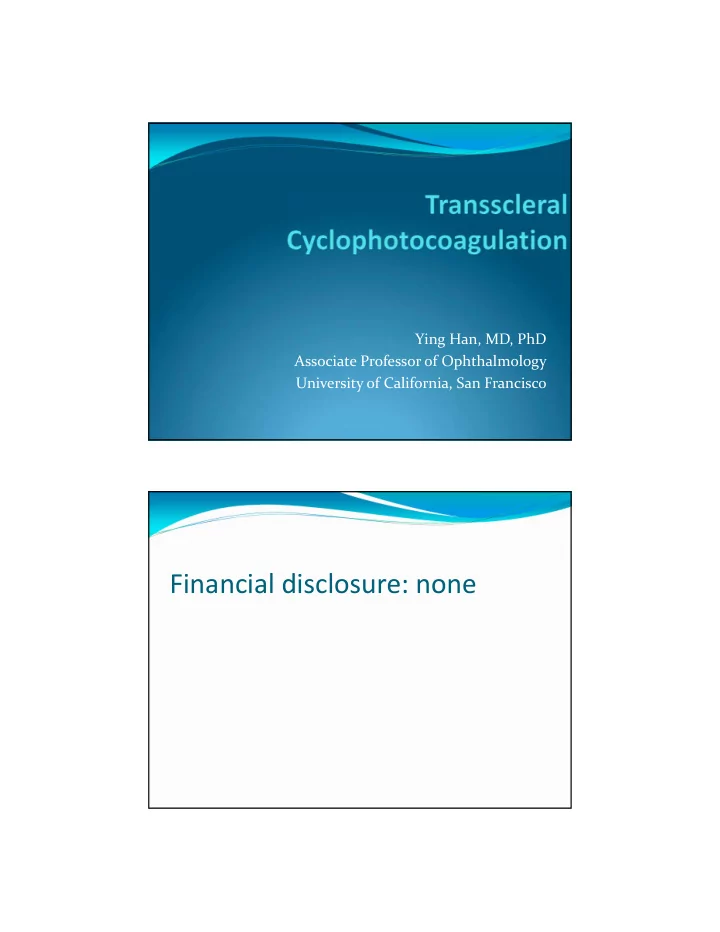

Ying Han, MD, PhD Associate Professor of Ophthalmology University of California, San Francisco Financial disclosure: none
Cyclophotocoagulation Transclerarl approach (TCP) Continuous mode: traditional TCP Micropulse mode: Micropulse TCP Endocyclophotocoagulation (ECP) Anterior approach via limbus Posterior approach via pars plana Traditional TCP Two types: Nd:YAG and Diode laser (810nm) Laser is absorbed by melanin pigment of ciliary body Mechanism: Destruction of the ciliary bodies and decreasing aqueous production. May increase outflow via blood autoregulation and immunologic response.
Traditional TCP Mainly used to treat refractory glaucoma, including end ‐ stage painful eye. High complication rate: Unpredictable outcomes Hypotony or Phthisis bulbi Visual deterioration Sympathetic ophthalmia (rare) 1.25 W and a 4.0 ‐ to 4.5 ‐ second duration were used. Eyes with other iris pigmentation received 1.5 W and a 3.5 ‐ to 4.0 ‐ second duration treatment Traditional TCP – slow coagulation Traditional parameter: 1.75 W and 2.0 ‐ second duration Slow coagulation parameter: 1.25 W and a 4.0 ‐ to 4.5 ‐ second duration for dark or light brown irises. 1.5 W and a 3.5 ‐ to 4.0 ‐ second duration treatment for other iris pigmentation. Slow coagulation mode may lead to less postoperative inflammation Lee RK, Ophthalmology Glaucoma, 2018
Micropulse TCP Micropulse TCP Diode laser emits 810 nm Targeted to pigmented ciliary body epithelium Either decrease aqueous production or increase uveal outflow Kuchar et al. Lasers Med Sci 2015
Micropulse vs Continuous TCP On and off cycles More selective Less collateral damage – no histology damage Nearly cause no inflammation Tan, et al. Clin Exp Ophthalmol, 2010 Micropulse TCP Continuous TCP
Settings for Micropulse TCP Power: 2000mW Duty cycle: 31.3% Duration: 80s 1 ‐ 2 treatments per hemifield Key: slow movement and press firmly to sclera Kuchar et al. Lasers Med Sci 2015
Indication for Micropulse TCP Refractory glaucoma Primary treatment for open angle glaucoma High risk for incisional surgery Patients s/p corneal transplant
Advantage of Micropulse TCP No incisional surgery Quick procedure– 5 mins 80% of patients have good response IOP can be decreased to teens No need for oral Carbonic Anhydrase Inhibitor. Disadvantage of Micropulse TCP Still has complications (low risk) Minimal inflammation Minimal vision changes Mydriasis Vitreous hemorrhage (rare) Peripheral vitreous traction(rare) Hypotony (rare) Corneal epithelial defect
Disadvantage of Micropulse TCP Painful procedure Requires full retrobulbar block Or a quick general anesthesia The laser effect may last 1 ‐ 2 years Limited response in children
ECP Why do we need ECP? Decrease laser energy: without barrier of sclera 2000 mW vs 200 ‐ 400 mW Less complication Direct visualization and treatment of the ciliary processes.
Anterior ECP • Laser probe enters via limbal incision • Aim for ciliary bodies process • Treat 270 ‐ 360 degree • Power: 0.25 ‐ 0.4 W Treat until ciliary body shrink and turning white Indication for Anterior ECP • Refractory glaucoma • Primary treatment combining with cataract surgery • minimally invasive glaucoma surgery (MIGS) • Especially for patients with plateau iris or PAC or PACG
ECP Plus (via Pars Plana) • Requires pars plana vitrectomy and the insertion of the ECP probe via the pars plana • Treat the whole ciliary body and pars plana ECP Plus • Requires pars plana vitrectomy and the insertion of the ECP probe via the pars plana • Treat the whole ciliary body and pars plana
ECP Plus ECP Plus has better outcome
ECP Plus has better outcome • Higher success rate for refractory glaucoma • 80% success in 2 years follow up • Has potential to obtain IOP of 8 ‐ 12mmHg range • Clinical trial is needed to compare ECP plus vs standard approach to treat refractory glaucoma.
Disadvantage of ECP Plus • Requires pars plana vitrectomy • Complication as traditional anterior ECP • IOL dislocation • macular edema • postoperative inflammation Summary • Newer laser treatments, such as micropulse TCP, ECP plus, provide better approach to treat primary and refractory glaucoma.
Thank you!
Recommend
More recommend